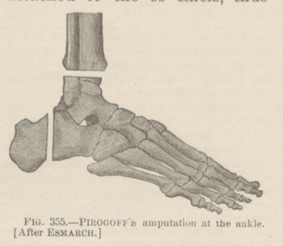Title: Smith, S.
Source text: The Medical and Surgical History of the War of the Rebellion. (1861-65.), Part 3, Volume 2 (Washington, DC: Government Printing Office, 1883), 604.
Civil War Washington ID: med.d2e23631
TEI/XML: med.d2e23631.xml
CASE 885.—Private S. Smith, Co. K, 86th New York, aged 47 years, was wounded at the Wilderness, May 10, 1864, by two minié balls, one of which passed through the left foot and fractured the tarsal bones; the other produced a flesh wound of the dorsal region near the spine. Several days after receiving the injury the wounded man was admitted to Harewood Hospital, Washington, where he did well up to May 23d. From that date his mind became wandering and delirious, his left arm and right leg keeping up constant motion. Irritation from the wound was suspected as the cause of this unusual action, and amputation was deemed necessary on May 25th. when Surgeon R. B. Bontecou, U. S. V., performed the operation by his modification of Pirogoff's method at the ankle joint. The patient improved after the amputation, all symptoms of derangement of mind disappeared, and he became perfectly conscious. Ether was used as the anæsthetic. The patient continued to do well up to June 1st, when pyæmic symptoms appeared, the wound ceased to suppurate, and rigors set in; skin hot and dry. In spite of a supporting treatment the patient gradually grew weaker. He died July 19, 1864. The tarsal bones, together with the malleoli and a thin section of the tibia, removed at the amputation (Spec. 3054), with the history, were contributed to the Museum by the operator.
